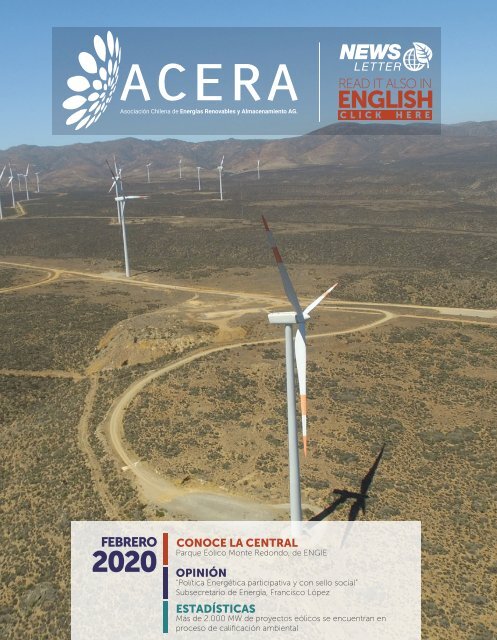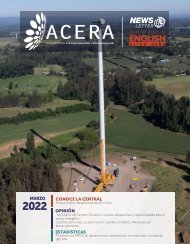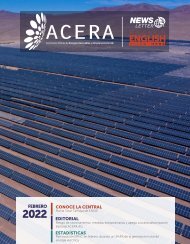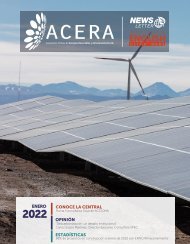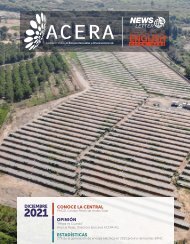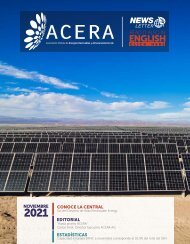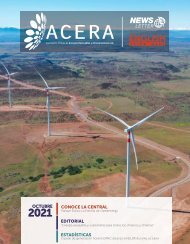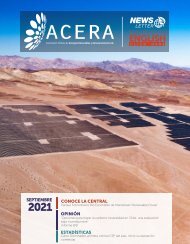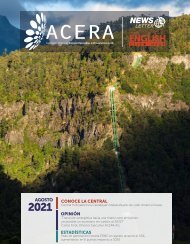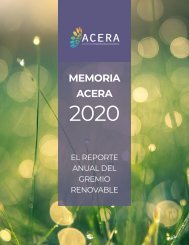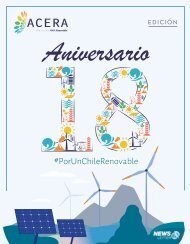Newsletter ACERA - Febrero 2020
Create successful ePaper yourself
Turn your PDF publications into a flip-book with our unique Google optimized e-Paper software.
READ IT ALSO IN<br />
ENGLISH<br />
FEBRERO<br />
<strong>2020</strong><br />
CONOCE LA CENTRAL<br />
Parque Eólico Monte Redondo, de ENGIE<br />
OPINIÓN<br />
“Política Energética participativa y con sello social”<br />
Subsecretario de Energía, Francisco López<br />
ESTADÍSTICAS<br />
Más de 2.000 MW de proyectos eólicos se encuentran en<br />
proceso de calificación ambiental
CONOCE<br />
la central<br />
Parque eólico<br />
MONTE REDONDO<br />
Proyecto: Parque eólico Monte Redondo<br />
Tecnología: Eólica<br />
Empresa Socia de <strong>ACERA</strong>: ENGIE<br />
Potencia Instalada: 48 MW<br />
Región: Coquimbo<br />
Sistema al que inyecta: Sistema Eléctrico Nacional<br />
Hace 10 años, ENGIE puso en marcha el parque eólico Monte<br />
Redondo, uno de los primeros proyectos renovables de la<br />
compañía en Chile. Esta central cuenta con 19 aerogeneradores<br />
de una capacidad de 2 MW, lo que significa la reducción de<br />
emisiones de unas 68 mil toneladas de CO2 al año, que<br />
equivale a quitar de circulación a 15 mil autos. ENGIE ha<br />
continuado con su visión puesta en el desarrollo de energías<br />
renovables, lanzando recientemente un plan de inversión<br />
renovable.<br />
“La apuesta renovable de ENGIE”<br />
En octubre de 2019, ENGIE lanzó la fase de construcción de su<br />
Plan de Inversión Renovable por 1.000 MW, que comienza con<br />
los tres primeros proyectos ubicados en la Región de<br />
Antofagasta. Se trata del Parque Eólico Calama, Planta Solar<br />
Capricornio, que ya iniciaron su construcción, y la Planta Solar<br />
Tamaya, cuyo inicio de obras se prevé para el primer trimestre<br />
del <strong>2020</strong>. Estos tres primeros proyectos tendrán una capacidad<br />
de 370 MW aproximadamente y generarán cerca de 1.000<br />
empleos directos en momentos punta de contratación.
ÍN<br />
DI<br />
CE<br />
04.<br />
05.<br />
08.<br />
10.<br />
Clean<br />
11.<br />
RWE<br />
OPINIÓN<br />
“Política Energética participativa y con sello social”<br />
Francisco López, Subsecretario de Energía.<br />
NOTICIAS<br />
- Ministra del Medio Ambiente explica la importancia de la igualdad<br />
de género en la lucha contra el cambio climático<br />
- El Parque Nacional Patagonia estrenó inédito sistema de energía<br />
100% renovable<br />
- Cambio de Fecha: Cena Anual de las Energías Renovables <strong>2020</strong><br />
- Colbún ingresa a evaluación ambiental proyecto eólico que sería<br />
el más grande de Latinoamérica<br />
ESTADÍSTICAS<br />
Más de 2.000 MW de proyectos eólicos se encuentran en proceso<br />
de calificación ambiental<br />
NUEVOS SOCIOS<br />
Capital Energy<br />
Sparber Group<br />
Total Eren<br />
VDB Energía Circular<br />
CONOCE A NUESTROS SOCIOS<br />
Renewables Chile<br />
Siemens Gamesa Renewable Energy<br />
13.<br />
COMITÉS TÉCNICOS<br />
14.<br />
EVENTOS<br />
16.<br />
READ IT ALSO IN ENGLISH
04.<br />
POLÍTICA ENERGÉTICA PARTICIPATIVA<br />
Y CON SELLO SOCIAL<br />
Desde 2015, Chile cuenta con una Política Energética Nacional articulada<br />
sobre la base de avances de años anteriores y sobre consensos de<br />
diversos actores. Como parte de sus compromisos, se estableció efectuar<br />
una actualización cada cinco años, para incorporar cambios tecnológicos<br />
y el surgimiento de nuevas prioridades para la sociedad que pudiesen<br />
modificar el escenario energético proyectado. Como Ministerio de<br />
Energía aceptamos este desafío, impulsados por los nuevos compromisos<br />
adquiridos por nuestro Gobierno de retirar las centrales a carbón al 2040<br />
y alcanzar la carbono-neutralidad al 2050.<br />
O<br />
PI<br />
NIÓN<br />
Francisco<br />
López<br />
Subsecretario de Energía<br />
A principios de octubre, comenzamos una serie de talleres participativos a<br />
lo largo de todo el país, convencidos de que la participación ciudadana es<br />
un insumo que enriquece y mejora las políticas públicas, y por la<br />
necesidad de abrir más espacios para escuchar y considerar las visiones,<br />
los anhelos y las preocupaciones de los chilenos en torno a la energía.<br />
Seguiremos con este proceso de actualización durante todo <strong>2020</strong>.<br />
Durante marzo, ampliaremos la realización de talleres ciudadanos a<br />
nuevas localidades regionales incluyendo la visión de zonas rurales. De<br />
manera similar al proceso anterior, convocaremos a grupos de expertos<br />
por temáticas en todo el país, y crearemos un nuevo Comité Consultivo<br />
para la Política Energética Nacional. Buscamos que esta instancia<br />
política-estratégica esté conformada por actores clave de diversos<br />
sectores transversales a la energía, provenientes del ámbito público,<br />
privado, académico y de la sociedad civil, y estará a cargo de entregar una<br />
propuesta de Hoja de Ruta al Ministerio de Energía.<br />
En este sentido, la información levantada durante los talleres participativos<br />
será fundamental para entregar insumos a las instancias técnicas y, hacia<br />
el final del año, desplegar una nueva ronda de encuentros ciudadanos<br />
para presentar los resultados del proceso y recoger opiniones acerca de<br />
los objetivos y lineamientos de la nueva política, que finalmente será<br />
sometida a consulta pública y a un proceso de Evaluación Ambiental<br />
Estratégica.<br />
Sabemos que las energías limpias son las protagonistas en la transición<br />
energética que vivimos. Por eso, cualquier intento de actualizar la política<br />
energética a largo plazo debe considerar la voz de quienes hoy impulsan<br />
su crecimiento. Quienes hoy lideran esta industria jugarán un rol<br />
fundamental en alcanzar las metas que tenemos como país. Desde lo<br />
público, queremos invitarlos a sumarse a las instancias de participación<br />
que seguirán en este proceso, para construir entre todos, con distintas<br />
visiones, una energía cada vez más humana y más ciudadana.
05.<br />
NO<br />
TI<br />
CIAS<br />
Ministra del Medio<br />
Ambiente explica la<br />
importancia de la igualdad<br />
de género en la lucha<br />
contra el cambio climático<br />
Durante el mes de febrero, la Ministra del Medio Ambiente, Carolina<br />
Schmidt, participó de la XIV Conferencia Regional sobre la Mujer de<br />
América Latina y el Caribe junto a la Ministra la Mujer y Equidad de<br />
Género, Isabel Plá, y la Secretaria Ejecutiva de la CEPAL (Comisión<br />
Económica para América Latina y el Caribe), Alicia Barcena.<br />
En el marco del panel “Cambio climático: Tendencias, oportunidades y<br />
desafíos para la igualdad de género”, la secretaria de Estado explicó la<br />
importancia de integrar a las mujeres en esta materia medioambiental.<br />
“Las mujeres somos más vulnerables a los efectos del cambio<br />
climático, pero también somos importantes agentes de cambio. La<br />
perspectiva de género juega un papel fundamental en la comprensión<br />
del impacto desproporcionado del cambio climático y la pérdida de<br />
biodiversidad, debido a las desigualdades estructurales existentes para<br />
reducir las brechas”, comentó.<br />
En la instancia, la Ministra fue enfática en decir que la justicia social es<br />
clave en la acción climática. “No es posible un desarrollo sostenible sin<br />
las mujeres involucradas con capacidad de incidencia en las políticas<br />
de cambio climático. Necesitamos a tomadoras de decisión<br />
desarrollando políticas climáticas para la agenda 2030. Debemos<br />
empoderar a las tomadoras de decisiones”, señaló.<br />
Fuente: Prensa COP 25<br />
El Parque Nacional Patagonia estrenó inédito<br />
sistema de energía 100% renovable<br />
El proyecto, creado por Tompkins Conservation, permitió terminar<br />
con el uso de hidrocarburos, gracias a 280 paneles solares y dos<br />
turbinas. El nuevo sistema de energía combina la generación<br />
hidráulica y fotovoltaica. Está compuesto por dos turbinas, una<br />
pequeña de 12 kW y una grande de 22 kW, además de 280 paneles<br />
solares de 275 W cada uno y un grupo de baterías de ion litio que<br />
almacenan la energía y la distribuye. Con estos equipos, la generación<br />
llega hasta los 115 kW en su punto máximo, lo que permite mantener<br />
la electricidad en el parque las 24 horas.<br />
La idea de Conaf es replicarlo en otras zonas. Según la corporación<br />
forestal, se trata del sistema de energía renovable más avanzado y<br />
completo dentro de un parque nacional de Chile. “Doug (Tompkins)<br />
siempre soñó con implementar un sistema de energía que permitiera<br />
que el parque fuese autosuficiente”, cuenta Dagoberto Guzmán, ex<br />
superintendente del parque.<br />
“Este sistema reemplaza a los grupos diésel que usábamos en verano<br />
con 16 horas de generación de energía en petróleo”, comenta<br />
Guzmán, quien lideró el proyecto. “Solamente en combustible, aquí se<br />
gastaban 120 litros de diésel al día. Eso tiene un gran impacto y, para<br />
reducirlo, se hacían cortes de luz todos los días durante toda la noche,<br />
pero ahora ya no es así”.<br />
Fuente: El Mercurio<br />
Fuente Foto: Fundación Imagen de Chile
LA ASOCIACIÓN CHILENA DE ENERGÍAS RENOVABLES<br />
Y ALMACENAMIENTO – <strong>ACERA</strong> AG.<br />
Realizará una nueva versión de la Cena Anual de las Energías Renovables.<br />
17 DE MARZO<br />
19:30 hrs / CASA PIEDRA<br />
Av. Monseñor Escrivá de Balaguer 5600, Vitacura, Santiago<br />
Entrada General: $88.900 + IVA<br />
Entrada Socios Colaboradores: $75.900 + IVA<br />
VENDIDA<br />
Entrada Socios <strong>ACERA</strong>: $72.900 + IVA*<br />
*Las empresas socias de <strong>ACERA</strong> tienen un cupo liberado, adicionales pagan valor socio.<br />
COMPLETE FORMULARIO DE INSCRIPCIÓN<br />
CONTACTO COMERCIAL:<br />
Paula Bustos / Paula.bustos@acera.cl / +56 9 9200 9825<br />
Colaboradores<br />
Platinum<br />
ORGANIZADO POR<br />
Gold<br />
Supporting
07.<br />
Cambio de Fecha: Cena Anual de<br />
las Energías Renovables <strong>2020</strong><br />
La Cena Anual de las Energías Renovables, evento que <strong>ACERA</strong> realiza<br />
cada año y que reúne a las principales autoridades y ejecutivos del<br />
sector energético, se adelantó una semana.<br />
El último tiempo ha sido muy vertiginoso para el país y la industria y el<br />
principal evento sectorial no se quedó atrás. Por motivos de fuerza<br />
mayor, la cena tuvo que cambiar de fecha, quedando agendado<br />
finalmente para el martes 17 de marzo, a las 19.30 horas, en<br />
CasaPiedra.<br />
El Ministro de Energía, Juan Carlos Jobet, la principal actividad<br />
sectorial, ha confirmado su participación en la #CenaRenovable <strong>2020</strong><br />
donde nos acompañará con unas palabras al cierre de los discursos,<br />
espacio en el cual los representantes de <strong>ACERA</strong> también entregarán el<br />
balance y proyecciones de la industria renovable a los presentes.<br />
El evento, que este año cuenta con las empresas Acciona, Energy<br />
Development Corporation-EDC, Engie, Huawei e ISA Interchile como<br />
auspiciadores platinum, Goldwind, Mainstream Renewable Power, SMA<br />
y Transelec como auspiciadores gold y Aela Energía, Atlas Renewable<br />
Energy, Imagen de Chile, Moray Energy Consulting y SMA como<br />
supporting sponsor, se ha posicionado como un “must” para las<br />
autoridades y ejecutivos/as del sector y que, en su última versión,<br />
realizada en marzo de 2019, recibió a cerca de 800 asistentes.<br />
La Cena Anual de las Energías Renovables <strong>2020</strong> se realiza en<br />
colaboración con la Asociación de Concentración Solar de Potencia<br />
(ACSP) y la Asociación Chilena de Hidrógeno (H2 Chile).<br />
Colbún ingresa a evaluación ambiental<br />
proyecto eólico que sería el más<br />
grande de Latinoamérica<br />
En el marco de su plan de crecimiento a partir de energías renovables,<br />
Colbún ingresó al Servicio de Evaluación Ambiental de la Región de<br />
Antofagasta el Estudio de Impacto Ambiental (EIA) del proyecto<br />
eólico Horizonte, iniciativa ubicada aproximadamente a 130<br />
kilómetros de la localidad de Taltal.<br />
“El proyecto Horizonte es un paso importante no solo para nuestra<br />
estrategia de crecimiento a través del desarrollo de energías<br />
renovables, sino también para la transición energética que está<br />
viviendo nuestro país hacia energías sin emisiones”, señaló el Gerente<br />
General de Colbún, Thomas Keller.<br />
Horizonte se emplazará en un predio de aproximadamente 8 mil<br />
hectáreas, que forma parte de una reserva de terrenos fiscales<br />
constituida por el Estado de Chile para el desarrollo de proyectos de<br />
generación de energía renovable en la comuna de Taltal.<br />
El futuro parque eólico contempla una capacidad instalada de hasta<br />
980 MW, mediante la instalación de 140 aerogeneradores, y ha<br />
incluido un acercamiento temprano con las comunidades cercanas<br />
mediante un proceso de Participación Ciudadana Anticipada,<br />
permitiendo recoger inquietudes y oportunidades de colaboración.<br />
Fuente: Colbún
08.<br />
REVISA MÁS<br />
ESTADÍSTICAS AQUÍ<br />
ESTA<br />
DÍS<br />
TICAS<br />
Tecnología<br />
ERNC<br />
Energía<br />
GWh<br />
<strong>Febrero</strong> <strong>2020</strong><br />
Energía<br />
%<br />
Variación<br />
mes<br />
anterior<br />
Variación<br />
año<br />
anterior<br />
2019<br />
YTD<br />
1.306 20,5% -6,1% 26% 20,5%<br />
GENERACIÓN DE ENERGÍA<br />
ELÉCTRICA SEN<br />
6.360 GWh<br />
Total de energía eléctrica generada<br />
20,5%<br />
Energía ERNC<br />
24,8%<br />
Hidroeléctrica convencional<br />
54,7%<br />
Termoelectricidad<br />
La participación ERNC de febrero<br />
de <strong>2020</strong> corresponde al 20,5%<br />
del total de la energía generada.<br />
Biogás<br />
Biomasa<br />
Eólica<br />
Geotérmica<br />
Mini Hidráulica Pasada<br />
Solar Fotovoltaica<br />
Hidráulica<br />
Convencional<br />
Hidráulica embalse<br />
Hidráulica Pasada<br />
Biogás Convencional<br />
Biomasa Convencional<br />
Carbón<br />
Cogeneración convencional<br />
Diésel<br />
Fuel Oil<br />
Gas Natural<br />
Total<br />
General<br />
13<br />
136<br />
384<br />
19<br />
128<br />
626<br />
801<br />
643<br />
0<br />
17<br />
2278<br />
11<br />
23<br />
0<br />
1281<br />
0,2 %<br />
2,1 %<br />
6,0 %<br />
0,3 %<br />
2,0 %<br />
9,8 %<br />
12,6 %<br />
10,1 %<br />
0,0 %<br />
0,3 %<br />
35,8 %<br />
0,2 %<br />
0,4 %<br />
0,0 %<br />
20,1 %<br />
-17,5 %<br />
9,5 %<br />
-3,7 %<br />
6,0 %<br />
-22,3 %<br />
-6,4 %<br />
-18,2 %<br />
-23,6 %<br />
0,0 %<br />
32,1 %<br />
1,6 %<br />
-7,6 %<br />
222,9 %<br />
0,0 %<br />
-2,0 %<br />
-16,5 %<br />
11,5 %<br />
56,1 %<br />
22,0 %<br />
-8,0 %<br />
25,6 %<br />
-12,7 %<br />
12,2 %<br />
0,0 %<br />
74,7 %<br />
8,8 %<br />
25,3 %<br />
-65,2 %<br />
0,0 %<br />
-1,2 %<br />
0,2 %<br />
2,0 %<br />
5,9 %<br />
0,3 %<br />
2,2 %<br />
9,8 %<br />
1.444 22,7% -20,7% -3,1% 24,8%<br />
13,5 %<br />
11,3 %<br />
Térmica 3.610 56,8% 0,8% 3,9% 54,7%<br />
0,0 %<br />
0,2 %<br />
34,4 %<br />
0,2 %<br />
0,2 %<br />
0,0 %<br />
19,7 %<br />
6.360 100% -6,4% 6% 100%<br />
GENERACIÓN DE ENERGÍA SEN<br />
Térmica Hidráulica Convencional ERNC<br />
7000<br />
6000<br />
5000<br />
GWh<br />
4000<br />
3000<br />
2000<br />
1000<br />
0<br />
Feb 19 Mar 19 Abr 19 May 19 Jun 19 Jul 19 Ago 19 Sep 19 Oct 19 Nov 19 Dic 19 Ene 20 Feb 20
09.<br />
PARTICIPACIÓN HORARIA ERNC<br />
Durante febrero de <strong>2020</strong> la máxima<br />
participación horaria ERNC alcanzó<br />
un 39,7%, y se produjo a las 16:00<br />
horas del 1 de febrero. El peak<br />
ERNC se compuso de un 62% de<br />
energía solar y un 25% de energía<br />
eólica, entre otros.<br />
Peak de uso<br />
39,7%<br />
de la energía<br />
producida fue ERNC<br />
Participación %<br />
5 10 20 30 40<br />
FEBRERO <strong>2020</strong><br />
29<br />
28<br />
27<br />
26<br />
25<br />
24<br />
23<br />
22<br />
21<br />
20<br />
19<br />
18<br />
17<br />
16<br />
15<br />
14<br />
13<br />
12<br />
11<br />
10<br />
09<br />
08<br />
07<br />
06<br />
05<br />
04<br />
03<br />
02<br />
01<br />
1 2 3 4 5 6 7 8 9 10 11 12 13 14 15 16 17 18 19 20 21 22 23 24<br />
HORA<br />
Porcentaje %<br />
25<br />
20<br />
18<br />
16<br />
14<br />
12<br />
10<br />
8<br />
6<br />
4<br />
2<br />
0<br />
2011 2012 2013 2014 2015 2016 2017 2018 2019 <strong>2020</strong><br />
Fecha<br />
2/24/19<br />
3/3/19<br />
4/14/19<br />
5/12/19<br />
6/23/19<br />
7/14/19<br />
8/31/19<br />
9/18/19<br />
10/20/19<br />
11/1/19<br />
12/25/19<br />
1/12/20<br />
2/1/20<br />
Hora<br />
17.00<br />
17.00<br />
16.00<br />
16.00<br />
16.00<br />
15.00<br />
16.00<br />
16.00<br />
16.00<br />
16.00<br />
16.00<br />
17.00<br />
16.00<br />
Máxima<br />
participación<br />
horaria ERNC<br />
40,5 %<br />
38,2 %<br />
36,3 %<br />
38,7 %<br />
36,1 %<br />
38,9 %<br />
41,9 %<br />
51,0 %<br />
52,3 %<br />
51,7 %<br />
47,2 %<br />
39,3 %<br />
39,7 %<br />
Obligación Reconocido Total ERNC<br />
Solar fotovoltaica Eólica Bioenergía Mini Hidráulica de Pasada Geotérmica
10.<br />
CAPACIDAD INSTALADA<br />
6.015 MW<br />
El aumento de la capacidad instalada ERNC se<br />
debe al ingreso de nuevas centrales solares<br />
fotovoltaicas y mini hidráulicas, aumentando en<br />
un 0.6% la capacidad ERNC respecto a enero.<br />
Térmica<br />
51,4%<br />
25.287 MW<br />
BESS<br />
0,2%<br />
Hidraúlica<br />
Convencional<br />
24,6%<br />
ERNC<br />
23,8%<br />
Tecnología<br />
ERNC<br />
Biogás<br />
Biomasa<br />
Eólica<br />
Geotérmica<br />
Mini Hidráulica Pasada<br />
Solar fotovoltaica<br />
Potencia<br />
Neta MW<br />
61<br />
414<br />
2.146<br />
48<br />
544<br />
2.802<br />
Potencia<br />
Neta %<br />
0,2 %<br />
1,6 %<br />
8,5 %<br />
0,2 %<br />
2,2 %<br />
11,1 %<br />
Variación<br />
mes<br />
anterior<br />
6.015 23,8% 0,6%<br />
0,0 %<br />
0,0 %<br />
0,0 %<br />
0,0 %<br />
0,0 %<br />
1,3 %<br />
Hidráulica Convencional 6.233 24,6% -0,1%<br />
Hidráulica embalse<br />
3.434 13,6 % 0,0 %<br />
Hidráulica Pasada<br />
2.799 11,1 % -0,1 %<br />
Térmica 12.985 51,4% -1,1%<br />
Carbón<br />
Cogeneración<br />
Fuel Oil Nro. 6<br />
Gas Natural<br />
Petróleo Diesel<br />
Propano<br />
Gas Licuado de Petróleo<br />
4.824<br />
18<br />
142<br />
4.860<br />
3.075<br />
14<br />
52<br />
19,1 %<br />
0,1 %<br />
0,6 %<br />
19,2 %<br />
12,2 %<br />
0,1 %<br />
0,2 %<br />
-3,0 %<br />
0,0 %<br />
0,0 %<br />
0,0 %<br />
-0,0 %<br />
0,0 %<br />
0,0 %<br />
BESS 54 0,2% 0,0%<br />
Almacenamiento 54 0,2% 0,0%<br />
Total General 25.287 100% -0,5%<br />
ESTATUS PROYECTOS<br />
ERNC SEGÚN AVANCE<br />
Proyectos ERNC en construcción<br />
4.713 MW<br />
60%<br />
Proyectos solares fotovoltaicos<br />
Tecnología<br />
Biogás<br />
Biomasa<br />
Eólica<br />
Geotérmica<br />
Mini Hidráulica Pasada<br />
Solar fotovoltaica<br />
Termosolar<br />
Hidráulica de bombeo<br />
Almacenamiento en baterías<br />
En Construcción<br />
MW<br />
5<br />
166<br />
1.467<br />
33<br />
93<br />
2.840<br />
110<br />
Aprobado<br />
MW<br />
14<br />
149<br />
4.959<br />
70<br />
290<br />
12.370<br />
2.192<br />
300<br />
En calificación<br />
MW<br />
30<br />
2.619<br />
58<br />
8.574<br />
600<br />
8<br />
Total General 4.713 20.344 11.889
11.<br />
CONOCE<br />
A NUESTROS<br />
SOCIOS<br />
Alfredo es chileno, casado y tiene cinco hijos: Tomás (12), Antonia (10), Felipe (7) y los<br />
mellizos Olivia y Rafael (8 meses). Estudió Ingeniería Civil en la Pontificia Universidad<br />
Católica.<br />
Sobre sus pasatiempos, Alfredo se confiesa como una persona muy familiar. “Disfruto<br />
mucho pasar la mayor cantidad de tiempo posible con mi familia y mis niños”, asegura.<br />
Además, en sus ratos libres, utiliza su telescopio para mirar la luna y las estrellas. “Es el<br />
momento que tengo para relajarme y reflexionar después de acostar a mis niños”.<br />
Cuenta que también se distrae tocando guitarra eléctrica. “Siempre quise aprender a<br />
tocar este instrumento y hace unos cinco años me metí a clases en School of Rock. No<br />
podía creer cuando, por fin, pude tocar una de mis canciones favoritas y que sonara<br />
‘razonablemente’ bien”, cuenta Alfredo.<br />
¿Por qué decidió orientar su carrera a la industria de la energía?<br />
Siempre pensé que la energía era clave para el desarrollo y calidad de vida de las personas,<br />
además de poder conocer lugares increíbles en todas partes de Chile. Me motivaba mucho<br />
contribuir en esta materia de manera sustentable, y qué mejor que trabajar para una<br />
empresa de energía renovable. Así lo he hecho desde el día uno de mi carrera profesional.<br />
Alfredo<br />
Zañartu<br />
Country Manager<br />
alfredo.zanartu@rwe.com<br />
Respecto a la importancia de la Energías Renovables en el sistema eléctrico del país,<br />
Alfredo las califica como fundamentales ya que “la estrategia de Chile en materia<br />
energética y su adelanto de cierre de carboneras implica la inyección de más energía<br />
renovable, proyectos que tendremos que construir. Esto representa una buena<br />
oportunidad para nuevos actores en el mercado como somos nosotros”.<br />
Además, destaca que los cambios que ha tenido el mercado en los últimos meses<br />
responden a la necesidad de hacer a este sector más accesible para todos los chilenos.<br />
“Considerando que la energía eléctrica, sobre todo cuando ésta es renovable, significa más<br />
y mejor calidad de vida para los chilenos”, afirma.<br />
Sobre RWE, Alfredo destaca que es una empresa centenaria, una de las principales de<br />
energía renovable a nivel global y uno de los mayores actores en Europa. “A nivel mundial,<br />
RWE Renewables cuenta con un portafolio diversificado de 9.5 GW de energía eólica<br />
onshore, offshore, hidroelectricidad, solar, etc. Además, la empresa tiene una<br />
configuración que le permite maximizar su valor al estar presente en toda la cadena desde<br />
el desarrollo, ingeniería a la operación y comercialización”, comenta.<br />
Añade que la compañía ha determinado ser “carbono neutral de aquí a finales de 2030,<br />
cerrando activos térmicos en Europa e incorporando al portafolio sólo energía renovable<br />
con una inversión de al menos EUR1.5 billones al año hasta 2030 en sus distintos<br />
mercados”.<br />
Uno de los procesos a destacar del último año para RWE, tiene relación con el cierre de la<br />
transacción con E.On, mediante la cual esta última transfirió todos sus activos de energía<br />
renovable a RWE. Alfredo destaca que con esto “nos convertimos en la cuarta empresa<br />
con capacidad instalada eólica a nivel global y la segunda con capacidad instalada eólica<br />
offshore, excluyendo China”.<br />
¿Por qué recomendaría ser socio de <strong>ACERA</strong>?<br />
<strong>ACERA</strong> es una buena plataforma para estar al día de lo que está ocurriendo en materia<br />
energética y, a la vez, compartir experiencias, generar conocimiento y contribuir al país<br />
con los ejemplos y prácticas que vemos en nuestras casas matrices y que pueden ser<br />
exitosas también en Chile.
12.<br />
Nicolás es chileno, tiene 36 años, está separado y tiene dos hijas, de tres y seis años. Es<br />
Ingeniero Civil Industrial de la Universidad Adolfo Ibáñez y tiene un MBA en Hamburg<br />
School of Business Administration. Este ingeniero disfruta su tiempo libre haciendo<br />
deportes, como jugar tenis y andar en bicicleta.<br />
¿Por qué decidió orientar su carrera a la industria de la energía?<br />
Desde la época universitaria que me interesó este tema, incluso saqué una mención en<br />
Energía y Medio ambiente en mi carrera. Con el tiempo, el tema me fue gustando cada vez<br />
más y ya no me veo en otra industria.<br />
Nicolás<br />
Saul<br />
Ingeniero de Ventas Senior<br />
nicolas.saul@siemensgamesa.com<br />
Respecto a la importancia de la participación de las Energías Renovables en el sistema<br />
eléctrico del país, Nicolás destaca dos factores relevantes: Primero, que son clave para el<br />
proceso de descarbonización de la matriz energética. “Esperamos tener en el futuro un país<br />
neutro en emisiones de carbono”, dice. En segundo lugar, es que contribuyen a bajar los<br />
precios de la energía al consumidor final “dado que son tecnologías que tienen un costo de<br />
operación más bajo que una central convencional y no tiene insumos, aportamos este<br />
beneficio económico a la sociedad”, explica.<br />
Respecto al aporte en la mitigación del cambio climático que estas tecnologías tienen,<br />
Nicolás destaca que “al ser una alternativa – o reemplazo- a la energía convencional, aportan<br />
a la descarbonización de la matriz energética, lo que se traduce en disminución de emisiones<br />
de CO2 en la atmósfera, fundamental para enfrentar el cambio climático”.<br />
Para Nicolás la generación de energía a través de recursos renovables no son una solución<br />
única, debe ser un mix de acciones. “Por supuesto que el reemplazo de los combustibles<br />
fósiles son el paso más relevante, pero también es importante la combinación con la<br />
electromovilidad, junto con los cambios en los patrones de consumo de la población, más<br />
conscientes, que nos lleven al objetivo final que es detener el calentamiento global”, asegura.<br />
Nicolás destaca que Siemens Gamesa, la empresa donde actualmente se desempeña como<br />
Ingeniero de Ventas, se orienta a la energía eólica, donde cuentan con una combinación de<br />
productos y servicios. “Tenemos aerogeneradores desde los 2.5 a los 5.8MW, los cuales<br />
fabricamos, transportamos e instalamos. Tenemos, también, servicios de operación y<br />
mantención de parques eólicos”, comenta. “A partir de la fusión del año 2017 entre Siemens<br />
Wind y Gamesa, hemos ido desarrollando productos con lo mejor de ambas tecnologías, que<br />
han tenido mucho éxito en países como México, Brasil y Chile”, añade.<br />
Nicolás destaca la cobertura que Siemens Gamesa tiene a lo largo de Chile. “Lo principal es<br />
dedicarnos a mantener una posición de vanguardia en nuestro rubro, generando modelos<br />
cada vez más eficientes y con capacidades para aprovechar el viento en emplazamientos<br />
donde la tecnología anterior no era viable. De esta manera, podemos aprovechar de mejor<br />
manera el recurso eólico disponible. Algo muy útil en Chile, donde el viento es -en generalclase<br />
3, es decir, relativamente bajo. Tenemos turbinas en parques eólicos operando desde<br />
Chiloé hasta Calama”, afirma.<br />
¿Por qué recomendaría ser socio de <strong>ACERA</strong>?<br />
<strong>ACERA</strong> es una organización que se ha convertido, desde mi punto de vista, en un líder de<br />
opinión en lo que se refiere a las energías renovables. No sólo en Chile, sino -según conozcotiene<br />
alianzas de colaboración también con otras asociaciones similares en Sudamérica,<br />
donde más de una de ellas ha intentado simular lo que ha conseguido <strong>ACERA</strong> en nuestro país.
13.<br />
COMI<br />
TÉS<br />
Técnicos<br />
Últimas sesiones<br />
FECHA COMITÉ TEMA<br />
20-02-<strong>2020</strong><br />
GENERACIÓN DISTRIBUIDA Y<br />
GENERACIÓN RESIDENCIAL<br />
Revisión de Informe Técnico Definitivo fijación Precio Nudo de<br />
Corto Plazo Primer Semestre <strong>2020</strong>.
14.<br />
EVEN<br />
TOS<br />
Marzo <strong>2020</strong><br />
Se viene...<br />
CENA ANUAL DE LAS ENERGÍAS RENOVABLES <strong>2020</strong> - 17 DE MARZO / CASAPIEDRA<br />
01<br />
02<br />
03 04 05 06 07 08<br />
09<br />
10<br />
11 12 13 14 15<br />
Gira Tecnológica<br />
Almacenamiento<br />
Gira Tecnológica<br />
Almacenamiento<br />
Gira Tecnológica<br />
Almacenamiento<br />
Gira Tecnológica<br />
Almacenamiento<br />
Gira Tecnológica<br />
Almacenamiento<br />
Camchal<br />
Düsseldorf - Alemania<br />
Camchal<br />
Düsseldorf - Alemania<br />
Camchal<br />
Düsseldorf - Alemania<br />
Camchal<br />
Düsseldorf - Alemania<br />
Camchal<br />
Düsseldorf - Alemania<br />
16 17<br />
18 19 20 21 22<br />
Cena Anual de las<br />
Energías Renovables<br />
<strong>ACERA</strong><br />
Santiago - Chile<br />
Seminario Geotermia y<br />
Flexibilidad: Su aporte<br />
a una matriz variable<br />
Consejo Geotérmico<br />
Santiago - Chile<br />
23 24<br />
25 26<br />
27 28 29<br />
Seminario de<br />
Operación y<br />
Mantenimiento de<br />
Sistemas Eléctricos de<br />
Potencia en la Gran<br />
Minería<br />
SAESA (STN)<br />
Iquique - Chile<br />
30<br />
31<br />
Foro Chileno-Alemán:<br />
Tecnologías para la<br />
Economía de<br />
Hidrógeno<br />
Camchal<br />
Santiago - Chile
@<strong>ACERA</strong>AG<br />
<strong>ACERA</strong><br />
General del Canto 230,<br />
Of 601 Providencia,<br />
Santiago<br />
+562 2236 3348<br />
informaciones@acera.cl<br />
@acera.ag<br />
<strong>ACERA</strong> AG
February<br />
<strong>2020</strong><br />
MEET THE PROYECT<br />
Monte Redondo Wind Farm, of ENGIE<br />
OPINION<br />
“Participatory Energy Policy with social compromise”<br />
Undersecretary of Energy, Francisco López<br />
STATISTICS<br />
More than 2,000 MW of wind projects were admitted to<br />
environmental permit process
MEET<br />
the proyect<br />
Wind Farm<br />
MONTE REDONDO<br />
Project: Monte Redondo Wind Farm<br />
Technology: Wind<br />
<strong>ACERA</strong> member company: ENGIE<br />
Installed Power: 48 MW<br />
Region: Coquimbo<br />
Injected Grid: National Electric System<br />
Ten years ago, ENGIE launched the Monte Redondo wind farm,<br />
one of the company's first renewable projects in Chile. This plant<br />
has 19 wind turbines with a capacity of 2 MW, which means<br />
reducing emissions by about 68 thousand tons of CO2 per year,<br />
which is equivalent to removing 15 thousand cars from<br />
circulation. ENGIE continues with its view to renewable energy<br />
development, recently launching a renewable investment plan.<br />
"ENGIE's Renewable Bet"<br />
In October 2019, ENGIE launched the construction phase of its<br />
1,000 MW Renewable Investment Plan, which begins with the first<br />
three projects located in the Antofagasta Region. It is the Calama<br />
Wind Farm, Capricorn Solar Plant, which has already started its<br />
construction, and the Tamaya Solar Plant, whose construction is<br />
planned for the first quarter of <strong>2020</strong>. These first three projects will<br />
have a capacity of approximately 370 MW and will generate about<br />
1,000 direct jobs at peak hiring times.
IN<br />
DEX<br />
04.<br />
05.<br />
08.<br />
10.<br />
Clean<br />
11.<br />
RWE<br />
OPINION<br />
“Participatory Energy Policy with social compromise”<br />
Francisco López, Undersecretary of Energy<br />
NEWS<br />
- Environment Minister explains the importance of Gender Equality in<br />
Combating Climate Change<br />
- Patagonia National Park debuted unprecedented 100% Renewable<br />
Energy system<br />
- Change of Date: Annual Renewable Energies Dinner <strong>2020</strong><br />
- The largest wind project of Latin America entered in<br />
environmental assessment<br />
STATISTICS<br />
More than 2,000 MW of wind projects were admitted to environmental<br />
permit process<br />
NEW MEMBERS<br />
Capital Energy<br />
Sparber Group<br />
Total Eren<br />
VDB Energía Circular<br />
MEET OUR MEMBERS<br />
Renewables Chile<br />
Siemens Gamesa Renewable Energy<br />
13.<br />
TECHNICAL COMMITTEES<br />
16.<br />
EVENTS
04.<br />
PARTICIPATORY ENERGY POLICY WITH<br />
SOCIAL COMPROMISE<br />
Since 2015, Chile has a National Energy Policy articulated on the base of<br />
advances from previous years and consensus from various actors. As part<br />
of its commitments, an update was established every five years, to<br />
incorporate technological changes and the emergence of new priorities<br />
for society that could modify the projected energy scenario. As Ministry<br />
of Energy we accept this challenge, driven by our Government's new<br />
commitments to withdraw coal-fueled plants by 2040 and achieve<br />
carbon-neutrality by 2050.<br />
O<br />
PI<br />
NION<br />
Francisco<br />
López<br />
Undersecretary of Energy<br />
At the beginning of October, we started a series of participatory<br />
workshops throughout the country, convinced that citizen participation is<br />
an input that enriches and improves public policies, and due to the need<br />
to open more spaces to listen and consider the visions, longings and<br />
concerns of Chileans around energy.<br />
We will continue this upgrade process throughout <strong>2020</strong>. During March,<br />
we will expand the citizen workshops to new regional locations including<br />
rural areas. Similar to the previous process, we will convene expert<br />
groups by topic across the country, and create a new Advisory<br />
Committee for National Energy Policy. We seek that this political-strategic<br />
body is made up of key actors from various sectors across the energy<br />
industry, coming from the public, private, academic and civil society<br />
spheres, and will be in charge of delivering a roadmap proposal to the<br />
Ministry of Energy.<br />
In this sense, the information raised during the participatory workshops<br />
will be essential to deliver information to the technical bodies and,<br />
towards the end of the year, to deploy a new round of citizen meetings<br />
to present the results of the process and collect opinions on the<br />
objectives and guidelines of the new policy, which will eventually be<br />
submitted to public consultation and a Strategic Environmental<br />
Assessment process.<br />
We know that clean energies are the protagonists in the energy transition<br />
we live in. Therefore, any attempt to make a long-term update of the<br />
energy policy must consider the voice of those who today drive their<br />
growth. Those who lead this industry today will play a key role in<br />
achieving the goals we have as a country. From the public sector, we<br />
want to invite you to join the instances of participation that will continue<br />
in this process, to build among all, with different visions, an energy that is<br />
increasingly human and citizen-based.
05.<br />
NEWS<br />
Environment Minister<br />
explains the importance<br />
of Gender Equality in<br />
Combating Climate<br />
During the month of February, the Minister of Environment, Carolina<br />
Schmidt, participated in the XIV Regional women Conference of Latin<br />
America and the Caribbean together with the Minister for Women and<br />
Gender Equity, Isabel Plá, and the Executive Secretary of ECLAC<br />
(Economic Commission for Latin America and the Caribbean), Alicia<br />
Barcena.<br />
Within the framework of the panel "Climate Change: Trends,<br />
Opportunities and Challenges for Gender Equality", the Secretary of<br />
State explained the importance of integrating women into this<br />
environmental issue.<br />
"Women are more vulnerable to the effects of climate change, but we<br />
are also important agents of change. The gender perspective plays a<br />
key role in understanding the disproportionate impact of climate<br />
change and biodiversity loss, due to existing structural inequalities to<br />
reduce gaps," she said.<br />
In the instance, the Minister was emphatical to say that social justice is<br />
key to climate action. "Sustainable development is not possible without<br />
women involved with advocacy in climate change policies. We need<br />
-and must empower- women decision-makers to develop climate<br />
policies for the 2030 agenda," she said.<br />
Source: COP 25 Press<br />
Patagonia National Park debuted<br />
unprecedented 100% Renewable<br />
Energy system<br />
The project, created by Tompkins Conservation, made it possible to<br />
end the use of hydrocarbons, thanks to 280 solar panels and two<br />
turbines. The new energy system combines hydraulic and photovoltaic<br />
generation. It consists of two turbines, a small 12 kW and a large 22<br />
kW, plus 280 solar panels of 275 W each and a group of lithium-ion<br />
batteries that store and distribute energy. With this equipment,<br />
generation reaches 115 kW at its maximum, allowing electricity to be<br />
maintained in the park 24 hours a day.<br />
Conaf's idea is to replicate it in other areas. According to the forestry<br />
corporation, it is the most advanced and complete renewable energy<br />
system within a national park in Chile. "Doug (Tompkins) always<br />
dreamed of implementing an energy system that would allow the park<br />
to be self-sufficient," says Dagoberto Guzmán, former superintendent<br />
of the park.<br />
"This system replaces the diesel groups we used in the summer with<br />
16 hours of oil power generation," says Guzman, who led the project.<br />
"Only in fuel, 120 litres of diesel a day were spent here. That has a big<br />
impact and, to reduce it, power outages were made every day<br />
throughout the night, but now it's different.”<br />
Source: El Mercurio<br />
Source of Photo: Fundación Imagen de Chile
SOLD OUT
06. 07.<br />
Change of Date: Annual Renewable<br />
Energies Dinner <strong>2020</strong><br />
The Annual Renewable Energy Dinner, an event that <strong>ACERA</strong> holds every<br />
year and brings together the main authorities and executives of the energy<br />
sector, was brought forward by one week.<br />
The last time has been very dizzying for the country and industry and the<br />
main sectoral event was no exception. Due to force majeure, the dinner<br />
had to change the date, finally being scheduled for Tuesday, March 17, at<br />
19.30 hours, in CasaPiedra.<br />
The Minister of Energy, Juan Carlos Jobet, the main sectoral activity, has<br />
confirmed his participation in the #CenaRenovable <strong>2020</strong> where he will say<br />
a few words at the close of the speeches, space in which the<br />
representatives of <strong>ACERA</strong> will also deliver the balance sheet and<br />
projections of the renewable industry to those present.<br />
This year's event features the companies Acciona, Energy Development<br />
Corporation-EDC, Engie, Huawei and ISA Interchile as platinum sponsors,<br />
Goldwind, Mainstream Renewable Power, SMA and Transelec as gold<br />
sponsors and Aela Energía, Atlas Renewable Energy, Chile Image, Moray<br />
Energy Consulting and SMA as supporting sponsors, has positioned itself<br />
as a "must" for the industry’s authorities and executives and, in its last<br />
version, held in March 2019, received nearly 800 attendees.<br />
The Annual Renewable Energy Dinner <strong>2020</strong> is held in collaboration<br />
with the Association of Solar Power Concentration (ACSP) and the Chilean<br />
Hydrogen Association (H2 Chile).<br />
The largest wind project of Latin<br />
America entered in environmental<br />
assessment<br />
As part of its renewable energy growth plan, Colbún submitted<br />
the Horizonte wind project’s Environmental Impact Study (EIA)<br />
to the Antofagasta Region Environmental Assessment Service.<br />
The project is located approximately 130 kilometers from the<br />
town of Taltal.<br />
"The Horizonte project is an important step not only for our<br />
growth strategy through the development of renewable energy,<br />
but also for the energy transition that our country is experiencing<br />
towards emissions-free energy," said the General Manager of<br />
Colbún, Thomas Keller.<br />
Horizonte will be located on a site of approximately 8 thousand<br />
hectares, which is part of a reserve of tax land constituted by the<br />
State of Chile for the development of renewable energy<br />
generation projects in the commune of Taltal.<br />
The future wind farm envisages an installed capacity of up to 980<br />
MW, through the installation of 140 wind turbines, and has<br />
included an early approach with nearby communities through an<br />
Early Citizen Participation process, allowing to pick up concerns<br />
and opportunities for collaboration.<br />
Source: Colbún
08.<br />
CHECK MORE<br />
STATISTICS HERE<br />
STA<br />
TIS<br />
TICS<br />
NATIONAL ELECTRICITY SYSTEM<br />
ELECTRIC POWER GENERATION<br />
6.360 GWh<br />
Total produced electric power<br />
20,5%<br />
NCRE Energy<br />
24,8%<br />
Conventional Hydroelectricity<br />
54,7%<br />
Thermoelectricity<br />
NCRE participation in February<br />
<strong>2020</strong> amounts to 20.5% of the<br />
total generated energy.<br />
Technology<br />
NCRE<br />
Biogas<br />
Biomass<br />
Wind<br />
Geothermal<br />
Run-of-river mini-hydro<br />
Solar Photovoltaic<br />
Conventional<br />
Hydraulic<br />
Dam Hydraulic<br />
Run-of-river Hydraulic<br />
Thermal<br />
Conventional Biogas<br />
Conventional Biomass<br />
Coal<br />
Conventional Cogeneration<br />
Diesel Oil<br />
Fuel Oil N°6<br />
Natural Gas<br />
Overall<br />
Total<br />
Net Power<br />
MW<br />
13<br />
136<br />
384<br />
19<br />
128<br />
626<br />
801<br />
643<br />
0<br />
17<br />
2278<br />
11<br />
23<br />
0<br />
1281<br />
February <strong>2020</strong><br />
Net Power<br />
%<br />
1.306 20,5% -6,1% 26% 20,5%<br />
0,2 %<br />
2,1 %<br />
6,0 %<br />
0,3 %<br />
2,0 %<br />
9,8 %<br />
12,6 %<br />
10,1 %<br />
0,0 %<br />
0,3 %<br />
35,8 %<br />
0,2 %<br />
0,4 %<br />
0,0 %<br />
20,1 %<br />
Prior<br />
month<br />
variation<br />
-17,5 %<br />
9,5 %<br />
-3,7 %<br />
6,0 %<br />
-22,3 %<br />
-6,4 %<br />
-18,2 %<br />
-23,6 %<br />
0,0 %<br />
32,1 %<br />
1,6 %<br />
-7,6 %<br />
222,9 %<br />
0,0 %<br />
-2,0 %<br />
Prior<br />
year<br />
variation<br />
-16,5 %<br />
11,5 %<br />
56,1 %<br />
22,0 %<br />
-8,0 %<br />
25,6 %<br />
-12,7 %<br />
12,2 %<br />
0,0 %<br />
74,7 %<br />
8,8 %<br />
25,3 %<br />
-65,2 %<br />
0,0 %<br />
-1,2 %<br />
2019<br />
YTD<br />
0,2 %<br />
2,0 %<br />
5,9 %<br />
0,3 %<br />
2,2 %<br />
9,8 %<br />
1.444 22,7% -20,7% -3,1% 24,8%<br />
13,5 %<br />
11,3 %<br />
3.610 56,8% 0,8% 3,9% 54,7%<br />
0,0 %<br />
0,2 %<br />
34,4 %<br />
0,2 %<br />
0,2 %<br />
0,0 %<br />
19,7 %<br />
6.360 100% -6,4% 6% 100%<br />
NATIONAL ELECTRICITY SYSTEM POWER GENERATION<br />
Thermal Conventional hydraulic NCRE<br />
7000<br />
6000<br />
5000<br />
GWh<br />
4000<br />
3000<br />
2000<br />
1000<br />
0<br />
Feb 19 Mar 19 Apr 19 May 19 Jun 19 Jul 19 Aug 19 Sept 19 Oct 19 Nov. 19 Dec. 19 Jan. 20 Feb 20
09.<br />
NCRE HOURLY PARTICIPATION<br />
During February <strong>2020</strong> the maximum<br />
NCRE’s hourly participation reached<br />
39.7%, at 16:00 on February 1. NCRE’s<br />
peak was composed of 62% of solar<br />
energy and 25% of wind energy,<br />
among others.<br />
Use peak<br />
39,7%<br />
of produced energy<br />
was NCRE<br />
Participation %<br />
5 10 20 30 40<br />
JANUARY <strong>2020</strong><br />
29<br />
28<br />
27<br />
26<br />
25<br />
24<br />
23<br />
22<br />
21<br />
20<br />
19<br />
18<br />
17<br />
16<br />
15<br />
14<br />
13<br />
12<br />
11<br />
10<br />
09<br />
08<br />
07<br />
06<br />
05<br />
04<br />
03<br />
02<br />
01<br />
1 2 3 4 5 6 7 8 9 10 11 12 13 14 15 16 17 18 19 20 21 22 23 24<br />
HOUR<br />
Percentage %<br />
25<br />
20<br />
18<br />
16<br />
14<br />
12<br />
10<br />
8<br />
6<br />
4<br />
2<br />
0<br />
2011 2012 2013 2014 2015 2016 2017 2018 2019 <strong>2020</strong><br />
Date<br />
2/24/19<br />
3/3/19<br />
4/14/19<br />
5/12/19<br />
6/23/19<br />
7/14/19<br />
8/31/19<br />
9/18/19<br />
10/20/19<br />
11/1/19<br />
12/25/19<br />
1/12/20<br />
2/1/20<br />
Hour<br />
17.00<br />
17.00<br />
16.00<br />
16.00<br />
16.00<br />
15.00<br />
16.00<br />
16.00<br />
16.00<br />
16.00<br />
16.00<br />
17.00<br />
16.00<br />
Maximum<br />
NCRE hourly<br />
participation<br />
40,5 %<br />
38,2 %<br />
36,3 %<br />
38,7 %<br />
36,1 %<br />
38,9 %<br />
41,9 %<br />
51,0 %<br />
52,3 %<br />
51,7 %<br />
47,2 %<br />
39,3 %<br />
39,7 %<br />
Mandatory NCRE Acknowledged NCRE Total NCRE<br />
Solar Photovoltaic Wind Bioenergy Run-of-river mini hydro Geothermal
10.<br />
INSTALLED CAPACITY<br />
6.015 MW<br />
The increase in NCRE’s installed capacity is due<br />
to the entry of new solar photovoltaic and mini<br />
hydro plants, increasing by 0.6% the NCRE’s<br />
capacity as compared to January.<br />
Thermal<br />
51,4%<br />
25.287 MW<br />
BESS<br />
0,2%<br />
Conventional<br />
Hydraulic<br />
24,6%<br />
NCRE<br />
23,8%<br />
Technology<br />
NCRE<br />
Biogas<br />
Biomass<br />
Wind<br />
Geothermal<br />
Run-of-river mini-hydro<br />
Solar Photovoltaic<br />
Conventional Hydraulic<br />
Dam Hydraulic<br />
Run-of-river Hydraulic<br />
Thermal<br />
Coal<br />
Cogeneration<br />
Fuel Oil No. 6<br />
Natural Gas<br />
Diesel Oil<br />
Propane<br />
Liquefied petroleum gas<br />
BESS<br />
Battery Storage System<br />
Overall Total<br />
Net Power<br />
MW<br />
61<br />
414<br />
2.146<br />
48<br />
544<br />
2.802<br />
Net Power<br />
%<br />
0,2 %<br />
1,6 %<br />
8,5 %<br />
0,2 %<br />
2,2 %<br />
11,1 %<br />
Prior<br />
month<br />
variation<br />
6.015 23,8% 0,6%<br />
0,0 %<br />
0,0 %<br />
0,0 %<br />
0,0 %<br />
0,0 %<br />
1,3 %<br />
6.233 24,6% -0,1%<br />
3.434 13,6 % 0,0 %<br />
2.799 11,1 % -0,1 %<br />
12.985 51,4% -1,1%<br />
4.824<br />
18<br />
142<br />
4.860<br />
3.075<br />
14<br />
52<br />
19,1 %<br />
0,1 %<br />
0,6 %<br />
19,2 %<br />
12,2 %<br />
0,1 %<br />
0,2 %<br />
-3,0 %<br />
0,0 %<br />
0,0 %<br />
0,0 %<br />
-0,0 %<br />
0,0 %<br />
0,0 %<br />
54 0,2% 0,0%<br />
54 0,2% 0,0%<br />
25.287 100% -0,5%<br />
STATE OF NCRE PROJECTS<br />
ACCORDING TO THEIR PROGRESS<br />
NCRE Projects in construction<br />
4.713 MW<br />
60%<br />
Solar photovoltaic Projects<br />
Technology<br />
Biogas<br />
Biomass<br />
Wind<br />
Geothermal<br />
Run-of-river mini-hydro<br />
Solar Photovoltaic<br />
Thermosolar<br />
Pump hydraulic<br />
Battery Storage System<br />
In Construction<br />
MW<br />
5<br />
166<br />
1.467<br />
33<br />
93<br />
2.840<br />
110<br />
Approved<br />
MW<br />
14<br />
149<br />
4.959<br />
70<br />
290<br />
12.370<br />
2.192<br />
300<br />
In Qualification<br />
MW<br />
30<br />
2.619<br />
58<br />
8.574<br />
600<br />
8<br />
Overall Total<br />
4.713 20.344 11.889
11.<br />
MEET OUR<br />
MEMBERS<br />
Alfredo is Chilean, married and has five children: Tomás (12), Antonia (10), Felipe (7),<br />
and the twins Olivia and Rafael (8 months). He studied Civil Engineer at the Pontificia<br />
Universidad Católica.<br />
About his hobbies, Alfredo admits being a very family person. "I really enjoy spending<br />
as much time as possible with my family and children," he says. In addition, in his<br />
sparetime, he watches the moon and stars with his telescope. "It's the time I have to<br />
relax and reflect after putting my kids to bed."<br />
He says he's also distracted playing electric guitar. "I always wanted to learn to play<br />
this instrument and about five years ago I started studying at the School of Rock. I<br />
couldn't believe when, at last, I was able to play one of my favorite songs and it<br />
would sound 'reasonably' ok," Alfredo says.<br />
Why did you decide to direct your career to the energy industry?<br />
I always thought that energy was key to people's development and quality of life, as well as<br />
being able to get to know amazing places everywhere in Chile. I was very motivated to<br />
contribute in this matter in a sustainable way, and what better than to work for a renewable<br />
energy company. That's how I've done it since day one of my career.<br />
Alfredo<br />
Zañartu<br />
Country Manager<br />
alfredo.zanartu@rwe.com<br />
Regarding the importance of Renewable Energy in the country's electricity system, Alfredo<br />
considers they are fundamental since "Chile's energy strategy and its advancement in the<br />
withdrawal of coal plants implies the injection of more renewable energy, projects that will<br />
have to be built. This represents a good opportunity for new players in the market as we<br />
are."<br />
In addition, he emphasizes that the changes in the market in recent months respond to the<br />
need to make this sector more accessible to all Chileans. "Considering that electricity,<br />
especially when it is renewable, means a better quality of life for Chileans," he says.<br />
Regarding RWE, Alfredo points out that it is a century-old company, one of the main<br />
renewable energy companies worldwide, and one of the largest players in Europe.<br />
"Globally, RWE Renewables has a diversified portfolio of 9.5 GW of onshore and offshore<br />
wind energy, hydroelectricity, solar energy, etc. In addition, the company has a<br />
configuration that allows it to maximize its value by being present through the entire chain<br />
from development, engineering to operation and commercialization," he says.<br />
He adds that the company has decided to be "carbon neutral by the end of 2030, closing<br />
thermal assets in Europe and incorporating into the portfolio only renewable energy with an<br />
investment of at least EUR1.5 trillion per year until 2030 in its different markets".<br />
One of the last year's highlights for RWE relates to the closing of the transaction with E.On,<br />
whereby the latter transferred all of its renewable energy assets to RWE. Alfredo points out<br />
that with this "we became the fourth company with installed wind capacity globally and the<br />
second with offshore wind installed capacity, excluding China".<br />
Why would you recommend being an <strong>ACERA</strong> member?<br />
<strong>ACERA</strong> is a good platform to keep up with what is happening in energy matters and, at the<br />
same time, share experiences, generate knowledge and contribute to the country with the<br />
examples and practices that we see in our headquartes and that can also be successful in<br />
Chile.
13.<br />
Nicolás is Chilean, 36 years old, separated, and has two daughters, three and six years<br />
old. He is an Industrial Civil Engineer from Adolfo Ibáñez University and holds an<br />
MBA from Hamburg School of Business Administration. This engineer enjoys his free<br />
time doing sports, such as playing tennis and cycling.<br />
Why did you decide to direct your career to the energy industry?<br />
From my university times I was interested in this topic, I even got a mention in Energy and<br />
Environment in my career. Over time, I became more and more involved and I can't see<br />
myself in another industry.<br />
Nicolás<br />
Saul<br />
Senior Sales Engineer<br />
nicolas.saul@siemensgamesa.com<br />
Regarding the importance of the participation of Renewable Energies in the country’s<br />
electricity system, Nicolás highlights two relevant factors: First, they are key to the<br />
process of decarbonization of the energy matrix. "We're hoping to have a carbon-neutral<br />
country in the future," he says. Secondly, they contribute to lower energy prices to the<br />
end consumer "since they are technologies with lower operating costs than a<br />
conventional power plant and have no inputs, we bring this economic benefit to society,"<br />
he explains.<br />
With regard to the contribution in the mitigation of climate change of these technologies,<br />
Nicolas emphasizes that "since they are an alternative – or replacement - to conventional<br />
energy, they contribute to the decarbonization of the energy matrix, which results in<br />
decreased CO2 emissions in the atmosphere, fundamental to tackling climate change".<br />
Nicolás believes that generating energy through renewable resources is not a single<br />
solution, it should be a mix of actions. "Of course, replacing fossil fuels is the most<br />
relevant step, but it's also important to combine with electromobility, along with changes<br />
in population consumption patterns, more conscious, that will lead us to the ultimate<br />
goal of stopping global warming," he says.<br />
Nicolás points out that Siemens Gamesa, the company where he is currently Sales<br />
Engineer, is oriented to wind energy, with a combination of products and services. "We<br />
have wind turbines from 2.5 to 5.8MW, which we manufacture, transport and install. We<br />
also provide wind farm operation and maintenance services," he says. "Since the 2017<br />
merger between Siemens Wind and Gamesa, we have been developing products with the<br />
best of both technologies, which have been very successful in countries such as Mexico,<br />
Brazil and Chile," he adds.<br />
Nicolás highlights the coverage that Siemens Gamesa has throughout Chile. "We are<br />
focused on maintaining a leading position in our field, generating increasingly efficient<br />
models with capabilities to take advantage of the wind in places where the previous<br />
technology was not viable. In this way, we can better leverage the available wind<br />
resource. Something very useful in Chile, where the wind is - in general - class 3, that is,<br />
relatively low. We have turbines in wind farms operating from Chiloé to Calama," he says.<br />
Why would you recommend being an <strong>ACERA</strong> member?<br />
<strong>ACERA</strong> is an organization that has, in my view, become a leader of opinion when it<br />
comes to renewable energy. Not only in Chile, but –as far as I know– it has collaborative<br />
alliances with other similar associations in South America, and more than one of them has<br />
tried to replicate what <strong>ACERA</strong> has achieved in our country.
14.<br />
Technical<br />
COMMI<br />
TEES<br />
Last sessions<br />
CHECK PRIOR<br />
COMMITTEES HERE<br />
DATE COMMITTE SUBJECT<br />
02-20-<strong>2020</strong><br />
DISTRIBUTED GENERATION AND<br />
HOUSING GENERATION<br />
Review of Final Technical Report on Short-Term Node Pricing First<br />
Semester <strong>2020</strong>.
15.<br />
CHECK<br />
EVENTS HERE<br />
E<br />
VENTS<br />
March <strong>2020</strong><br />
Soon...<br />
ANNUAL RENEWABLE ENERGIES DINNER <strong>2020</strong> - MARCH 17 / CASAPIEDRA<br />
01<br />
02<br />
03 04 05 06 07 08<br />
09<br />
10<br />
11 12 13 14 15<br />
Storage<br />
Technological Tour<br />
Storage<br />
Technological Tour<br />
Storage<br />
Technological Tour<br />
Storage<br />
Technological Tour<br />
Storage<br />
Technological Tour<br />
Camchal<br />
Düsseldorf - Germany<br />
Camchal<br />
Düsseldorf - Germany<br />
Camchal<br />
Düsseldorf - Germany<br />
Camchal<br />
Düsseldorf - Germany<br />
Camchal<br />
Düsseldorf - Germany<br />
16 17<br />
18 19 20 21 22<br />
Annual Renewable<br />
Energies Dinner<br />
<strong>ACERA</strong><br />
Santiago - Chile<br />
Seminar Geothermal and<br />
Flexibility: Contribution to<br />
a variable matrix<br />
Consejo Geotérmico<br />
Santiago - Chile<br />
23 24<br />
25 26<br />
27 28 29<br />
Seminar on Operation<br />
and Maintenance of<br />
Electric Power Systems<br />
in Large-scale Mining<br />
Gran Minería<br />
SAESA (STN)<br />
Iquique - Chile<br />
30<br />
31<br />
Chilean-German<br />
Forum: Technologies<br />
for the Hydrogene<br />
Economy<br />
Camchal<br />
Santiago - Chile
@<strong>ACERA</strong>AG<br />
<strong>ACERA</strong><br />
General del Canto 230,<br />
Of 601 Providencia,<br />
Santiago<br />
+562 2236 3348<br />
informaciones@acera.cl<br />
@acera.ag<br />
<strong>ACERA</strong> AG


